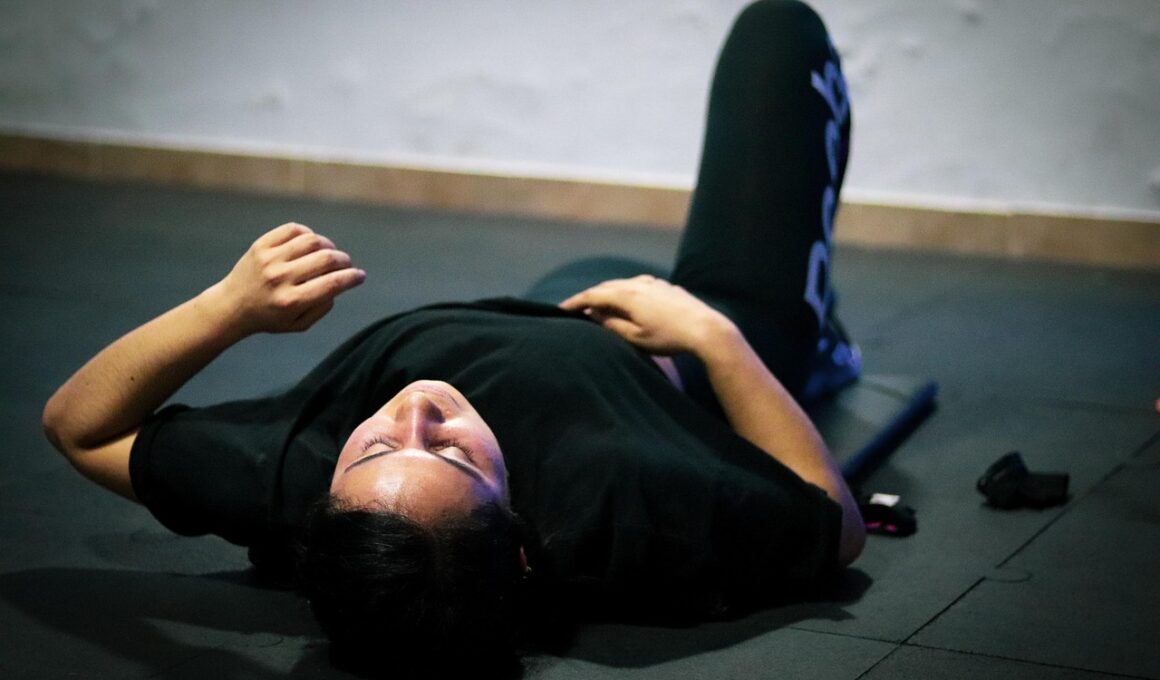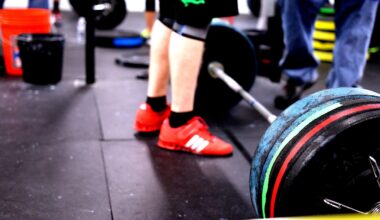Common Myths About Core Plyometric Training Debunked
Core plyometric training is often misunderstood, leading to numerous myths that persist within the fitness community. One prevalent myth is that plyometric exercises are solely for athletes aiming to improve their sports performance. In reality, these exercises, which emphasize explosive movements, also enhance stability and strength in non-athletic individuals. Anyone can benefit from core plyometrics, regardless of their fitness level or athletic background. Performance enhancement is just one of many benefits these workouts provide, including improved coordination and balance. Additionally, individuals who engage in regular core plyometric training may experience better posture and reduced risk of injury, making it essential for everyone. Another myth is that plyometrics are too dangerous or require advanced skills. It is crucial to understand that, when performed with proper technique and progressions, these workouts can be safely adapted to fit various abilities. For beginners, starting with low-impact versions of plyometric drills can pave the way for a safe progression to more demanding exercises. Investing time in understanding these training methods is invaluable for anyone looking to innovate their fitness approach.
A common misconception is that core plyometric training primarily targets the legs. While these workouts do emphasize lower body strength, they significantly engage the core muscles as well. Core plyometrics effectively combine stability and explosive power workouts, ensuring your abdominals, obliques, and back are strengthened. The dynamic movements involved in core plyometrics stimulate various muscle fibers, promoting overall body conditioning. Exercises such as medicine ball slams or plank jacks challenge not only your legs but also your trunk stability. As a result, these workouts enhance your overall athleticism, increasing performance across various activities. Additionally, core plyometric training improves neuromuscular coordination, helping to bridge the gap between strength and power. When practicing these movements, it is essential to maintain proper form and control to ensure that the correct muscles are engaged. Investing in the right instruction, whether through personal training or online resources, can vastly improve your confidence in performing these explosive exercises. This comprehensive engagement benefits daily activities and recreational sports, opening up possibilities for improved performance and injury prevention, adhering to both safety and efficiency in training.
When discussing core plyometric training, some believe that it is limited solely to a few well-known exercises, like box jumps or burpees. However, this couldn’t be further from the truth. In fact, there is a wide array of innovative and diverse exercises to explore within this training category. Options like plyometric rollouts, lateral bounds, and power push-ups can be included in your routine. Incorporating varied movements keeps your workouts fresh and can specifically target different muscle groups simultaneously. This approach promotes continued adaptation and reduces the likelihood of plateaus during training. It’s also essential to remember that implementing plyometric training should not require extensive time commitments. A short, intense session can yield significant results, making it practical for those with busy lifestyles. When designed thoughtfully, these workouts enhance cardiovascular endurance while building strength and power. Keeping sessions engaging and dynamic is crucial, as it leads to increased enthusiasm and motivation in workout routines. With the right mindset and variety, anyone can enjoy the benefits of core plyometrics, transforming their athletic journey for better performance and overall health.
Misunderstandings About Frequency
Another misconception surrounding core plyometric workouts is the frequency of training sessions. Many believe that frequent, excessive plyometric training is required to see benefits. In reality, recovery time is essential for muscle adaptation and injury prevention. Core plyometric workouts should ideally be performed two to three times per week, allowing adequate recovery between sessions. By doing so, you not only promote growth in strength and power but also minimize the risk of fatigue or overtraining. In this regard, it is critical to listen to your body and tailor your regimen accordingly. Balancing plyometric training with other forms of exercise, such as strength training and active recovery, ensures comprehensive fitness development. Furthermore, integrating periods of deloading or rest can greatly support long-term progress. This cyclical approach fosters a healthy and sustainable relationship with training, enabling continued performance improvements. Proper programming is vital for optimizing results, making expert advice beneficial. Overall, understanding the importance of recovery allows practitioners to confidently develop a successful and lasting workout strategy that incorporates core plyometric training into their fitness journey.
Another myth often associated with core plyometric workouts is the idea that they are strictly muscle-building routines. While they certainly enhance strength, this form of training also plays a significant role in improving agility and speed. By incorporating explosive movements into your routine, you develop fast-twitch muscle fibers that are crucial for athletic performance. Core plyometrics challenge not only your muscles but also your cardiovascular system, increasing your heart rate and promoting fat loss during and after workouts. As a result, many athletes and fitness enthusiasts alike turn to core plyometric training as a means to improve overall conditioning. In essence, these workouts cater to multiple fitness goals, making them incredibly versatile and valuable. Understanding the multifaceted benefits of these training approaches enables individuals to embrace various aspects of fitness, leading to well-rounded improvements. Engaging in core plyometric workouts fosters a holistic approach to training, allowing individuals to embody multiple athletic attributes simultaneously. With dedication to this training mode, participants can significantly enhance their functional fitness, making them ready for any challenge that comes their way.
One of the most impactful myths about core plyometrics is that they are not suitable for older adults or those with previous injuries. This misconception can be detrimental, as modified core plyometric exercises can be highly beneficial for this demographic. By incorporating lower-impact versions of traditional plyometric movements, older adults can safely enjoy the advantages of increased stability and strength. Exercises tailored to their abilities can enhance balance, agility, and injury prevention, fostering confidence in their physical capabilities. Moreover, engaging in core plyometric training helps maintain and improve bone density, a vital factor in healthy aging. Therefore, it is crucial to understand that with appropriate modifications, core plyometric workouts can be an integral part of a lifelong fitness regimen. Consulting with a fitness professional to create a customized program is essential for ensuring safety and effectiveness. By breaking down these myths, we open the door to greater accessibility and inclusivity in fitness environments. Ultimately, everyone can experience the benefits of core plyometrics regardless of age or fitness history, allowing them to participate fully in a healthier lifestyle.
As we explore the world of core plyometric training, it becomes evident that shedding misconceptions is vital for embracing this effective workout modality. Within the fitness community, misinformation can impede progress and discourage individuals from pursuing valuable training techniques. By debunking myths surrounding plyometrics, we empower individuals to tap into their explosive potential, drawing on the multitude of benefits that align with their unique fitness aspirations. Improved performance, increased strength, and better coordination are just a few dividends of incorporating core plyometrics into one’s routine. Furthermore, fostering a supportive environment among trainers and participants contributes to a more profound understanding of these training methods. Combined knowledge and dedicated perseverance create opportunities for all individuals to engage with core plyometric training fully. With proper instruction, a diverse range of exercises can also be customized for varying fitness levels. Leading to increased accessibility and participation encourages more people to experience the advantages of this versatile training method. Awareness and education play crucial roles in changing perceptions and removing barriers, making core plyometrics an integral choice for anyone seeking to elevate their fitness journey.
In conclusion, core plyometric workouts are surrounded by various myths that can limit their engage. It is crucial to recognize that these training sessions can benefit individuals of all ability levels, from beginners to advanced athletes. They not only enhance leg strength but also involve the core muscles and improve capabilities in functional fitness. Moreover, frequency and recovery are vital components of program design that must be managed wisely. Transitioning into plyometric training from other forms of exercise is achievable with proper guidance. It is equally essential to highlight that older adults can safely engage in these workouts and reap the rewards with appropriate modifications. Through education and understanding, individuals can overcome misconceptions, leading to greater participation in core plyometric training across all demographics. Their versatility, efficiency, and multiple benefits are undeniable. As health and fitness enthusiasts, we should continue exploring and expanding our knowledge about core plyometrics. By embracing these workouts, we create space for diverse training opportunities, carving out paths for personal growth, enhanced athletic performance, and a much healthier lifestyle. Ultimately, core plyometric workouts are not just a trend, but a valuable asset for achieving fitness goals.


